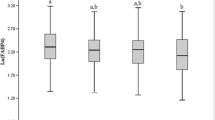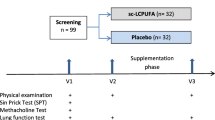Abstract
Background The dietary intake of certain fatty acids might have an impact on inflammatory processes in the lung and therefore contribute to the development of lung diseases like asthma or COPD. Methods In this study data from a population based cross-sectional study on respirator y health including measurement of fatty acids in serum phospholipids of 593 adults between 20 and 64 years of age were analyzed. Results Statistically significant positive associations were found between percentage predicted FEV1 (P = 0.0085) and FVC (P = 0.0267) and docosahexaenoic acid concentration in serum phospholipids in men. Dihomo-γ-linolenic acid content in serum phospholipids was significantly negatively associated with percentage predicted FEV1 (P = 0.0003) and FVC (P = 0.0045) and transformed dose-response slopes (P = 0.0488) in men. Palmitoleic acid was negatively associated with percentage predicted FEV1 (P = 0.0037) and FVC (P = 0.0029) in men. Other fatty acids in serum phospholipids did not consistently affect lung function parameters or bronchial hyperreactivity. Conclusion A high concentration of docosahexaenoic acid in serum phospholipids may have a protective effect on lung function. Because this long-chain n-3 polyunsaturated fatty acid is almost exclusively derived from marine oils, fish might have a beneficial effect on lung diseases.

Similar content being viewed by others
Abbreviations
- BHR:
-
Bronchial hyperresponsiveness
- COPD:
-
Chronic obstructive pulmonary disease
- LTB4 :
-
Leukotriene B4
- PGE2 :
-
Prostaglandin E2
- EPA:
-
Eicosapentaenoic acid
- DHA:
-
Docosahexaenoic acid
- PUFA:
-
Polyunsaturated fatty acids
- FEV1 :
-
Forced exspiratory volume in one second
- FVC:
-
Forced vital capacity
- ECRHS:
-
European community respiratory health survey
- DRS:
-
Dose-response slope
- TDRS:
-
Transformed dose-response slope
- OR:
-
Odds ratio
- β:
-
Regression coefficient
- SE:
-
Standard error
- PUFA:
-
Polyunsaturated fatty acids
- wt/wt:
-
Weight/weight
References
Seaton A, Godden DJ, Brown K. Increase in asthma: a more toxic environment or a more susceptible population? Thorax 1994; 49(2):171–4.
Black PN. The prevalence of allergic disease and linoleic acid in the diet. J Allergy Clin Immunol 1999;103(2 Pt 1):351–2.
Kankaanpaa P, Sutas Y, Salminen S, et al. Dietary fatty acids and allergy. Ann Med 1999;31(4):282–7.
Weiss ST. Diet as a risk factor for asthma. Ciba Found Symp 1997;206:244–57.
Schwartz J. Role of polyunsaturated fatty acids in lung disease. Am J Clin Nutr 2000;71(1 Suppl):393S–6
Burney PG, Luczynska C, Chinn S, et al. The European Community Respiratory Health Survey. Eur Respir J 1994;7(5):954–60
Nowak D, Heinrich J, Jorres R, et al. Prevalence of respiratory symptoms, bronchial hyperresponsiveness and atopy among adults: west and east Germany. Eur Respir J 1996;9(12):2541–52.
Trak-Fellermeier MA, Brasche S, Winkler G et al. Food and fatty acid intake and atopic disease in adults. Eur Respir J 2004;23(4):575–82.
Chinn S, Jarvis D, Luczynska C, et al. Individual allergens as risk factors for bronchial responsiveness in young adults. Thorax 1998;53(8):662–7.
Leynaert B, Bousquet J, Henry C, et al. Is bronchial hyperresponsiveness more frequent in women than in men? A population-based study. Am J Respir Crit Care Med 1997; 156(5):1413–20.
Chinn S, Burney P, Jarvis D, et al. Variation in bronchial responsiveness in the European community respiratory health survey (ECRHS). Eur Respir J 1997;10(11):2495–501.
Wassmer G, Jorres RA, Heinrich J, et al. The association between baseline lung function and bronchial responsiveness to methacholine. Eur J Med Res 1997;2(2):47–54.
Kolarovic L, Fournier NC. A comparison of extraction methods for the isolation of phospholipids from biological sources. Anal Biochem 1986;156(1):244–50.
Carnielli VP, Pederzini F, Vittorangeli R, et al. Plasma and red blood cell fatty acid of very low birth weight infants fed exclusively with expressed preterm human milk. Pediatr Res 1996;39(4 Pt 1):671–9.
Weiland SK, von Mutius E, Husing A, et al. Intake of trans fatty acids and prevalence of childhood asthma and allergies in Europe. ISAAC Steering Committee. Lancet 1999; 353(9169):2040–1.
Nagel G, Nieters A, Becker N, et al. The influence of the dietary intake of fatty acids and antioxidants on hay fever in adults. Allergy 2003;58(12):1277–84.
Trak-Fellermeier MA, Brasche S, Winkler G, et al. Food and fatty acid intake and atopic disease in adults. Eur Respir J 2004;23(4):575–82.
Leynaert B, Bousquet J, Henry C, et al. Is bronchial hyperresponsiveness more frequent in women than in men? A population-based study. Am J Respir Crit Care Med 1997;156(5):1413–20.
Shahar E, Boland LL, Folsom AR, et al. Docosahexaenoic acid and smoking-related chronic obstructive pulmonary disease. The Atherosclerosis Risk in Communities Study Investigators. Am J Respir Crit Care Med 1999;159(6):1780–5.
Woods RK, Raven JM, Walters EH, et al. Fatty acid levels and risk of asthma in young adults. Thorax 2004;59(2):105–10.
Nagel G, Linseisen J. Dietary intake of fatty acids, antioxidants and selected food groups and asthma in adults. Eur J Clin Nutr 2005;59(1):8–15.
Troisi RJ, Willett WC, Weiss ST, et al. A prospective study of diet and adult-onset asthma. Am J Respir Crit Care Med 1995;151(5):1401–8
Broadfield EC, McKeever TM, Whitehurst A, et al. A case-control study of dietary and erythrocyte membrane fatty acids in asthma. Clin Exp Allergy 2004;34(8):1232–6.
Butland BK, Fehily AM, Elwood PC. Diet, lung function, and lung function decline in a cohort of 2512 middle aged men. Thorax 2000;55(2):102–8.
Fluge O, Omenaas E, Eide GE, et al. Fish consumption and respiratory symptoms among young adults in a Norwegian community. Eur Respir J 1998;12(2):336–40.
Woods RK, Walters EH, Raven JM, et al. Food and nutrient intakes and asthma risk in young adults. Am J Clin Nutr 2003;78(3):414–21.
Schwartz J, Weiss ST. The relationship of dietary fish intake to level of pulmonary function in the first National Health and Nutrition Survey (NHANES I). Eur Respir J 1994;7(10):1821–4.
Schwartz J, Weiss ST. Dietary factors and their relation to respiratory symptoms. The Second National Health and Nutrition Examination Survey. Am J Epidemiol 1990;132(1):67–76.
Woods RK, Thien FC, Abramson MJ. Dietary marine fatty acids (fish oil) for asthma in adults and children. Cochrane Database Syst Rev 2002;(3):CD001283.
Wong KW. Clinical efficacy of n-3 fatty acid supplementation in patients with asthma. J Am Diet Assoc 2005;105(1):98–105.
Kirsch CM, Payan DG, Wong MY et al. Effect of eicosapentaenoic acid in asthma. Clin Allergy 1988;18(2):177–87.
Arm JP, Horton CE, Mencia-Huerta JM et al. Effect of dietary supplementation with fish oil lipids on mild asthma. Thorax 1988;43(2):84–92.
Serhan CN. Novel eicosanoid and docosanoid mediators: resolvins, docosatrienes, and neuroprotectins. Curr Opin Clin Nutr Metab Care 2005;8(2):115–21.
Serhan CN. A search for endogenous mechanisms of anti-inflammation uncovers novel chemical mediators: missing links to resolution. Histochem Cell Biol 2004;122(4):305–21.
Serhan CN. Novel omega—3-derived local mediators in anti-inflammation and resolution. Pharmacol Ther 2005;105(1):7–21.
Hong S, Gronert K, Devchand PR, et al. Novel docosatrienes and 17S-resolvins generated from docosahexaenoic acid in murine brain, human blood, and glial cells. Autacoids in anti-inflammation. J Biol Chem 2003;278(17):14677–87.
Becklake MR, Kauffmann F. Gender differences in airway behaviour over the human life span. Thorax 1999;54(12):1119-38.
Mueller JE, Frye C, Brasche S, et al. Association of hormone replacement therapy with bronchial hyper-responsiveness. Respir Med 2003;97(8):990–2.
Carlson CL, Cushman M, Enright PL, et al. Hormone replacement therapy is associated with higher FEV1 in elderly women. Am J Respir Crit Care Med 2001;163(2):423–8.
Balzano G, Fuschillo S, Melillo G et al. Asthma and sex hormones. Allergy 2001;56(1):13–20.
Arab L. Biomarkers of fat and fatty acid intake. J Nutr 2003;133(Suppl 3):925S–32.
Ma J, Folsom AR, Eckfeldt JH et al. Short- and long-term repeatability of fatty acid composition of human plasma phospholipids and cholesterol esters. The Atherosclerosis Risk in Communities (ARIC) Study Investigators. Am J Clin Nutr 1995;62(3):572–8.
Kew S, Mesa MD, Tricon S et al. Effects of oils rich in eicosapentaenoic and docosahexaenoic acids on immune cell composition and function in healthy humans. Am J Clin Nutr 2004;79(4):674–81.
Gibney MJ, Hunter B. The effects of short- and long-term supplementation with fish oil on the incorporation of n-3 polyunsaturated fatty acids into cells of the immune system in healthy volunteers. Eur J Clin Nutr 1993;47(4):255–9.
von Schacky C, Fischer S, Weber PC. Long-term effects of dietary marine omega-3 fatty acids upon plasma and cellular lipids, platelet function, and eicosanoid formation in humans. J Clin Invest 1985;76(4):1626–31.
Di Stasi D, Bernasconi R, Marchioli R, et al. Early modifications of fatty acid composition in plasma phospholipids, platelets and mononucleates of healthy volunteers after low doses of n-3 polyunsaturated fatty acids. Eur J Clin Pharmacol 2004;60(3):183–90.
Johnson MM, Swan DD, Surette ME et al. Dietary supplementation with gamma-linolenic acid alters fatty acid content and eicosanoid production in healthy humans. J Nutr 1997;127(8):1435–44.
Zeleniuch-Jacquotte A, Chajes V, Van Kappel AL, et al. Reliability of fatty acid composition in human serum phospholipids. Eur J Clin Nutr 2000;54(5):367–72.
Koletzko B, Innis SM. Lipids. In: Tsang R, Uauy R, Koletzko B, Zlotkin S, editors. Nutrition of the preterm infant. Scientific basis and practical application. 2nd ed. Cincinnati: Digital Educ Publ; 2005. p 97–139.
Acknowledgments
Sources of Support: Financially supported in part by German Research Council (Deutsche Forschungsgemeinschaft), Bonn, HEI 3294/1–1 and KO 912/8–1.
Author information
Authors and Affiliations
Corresponding author
Additional information
Authors contribution:
Iris Kompauer did the data analysis and wrote the paper.
Hans Demmelmair did laboratory work.
Berthold Koletzko did interpretation and discussion.
Gabriele Bolte did acquisition of funding, interpretation and discussion.
Jakob Linseisen did interpretation and discussion.
Joachim Heinrich did design, interpretation and discussion.
Rights and permissions
About this article
Cite this article
Kompauer, I., Demmelmair, H., Koletzko, B. et al. Association of fatty acids in serum phospholipids with lung function and bronchial hyperresponsiveness in adults. Eur J Epidemiol 23, 175–190 (2008). https://doi.org/10.1007/s10654-007-9218-y
Received:
Accepted:
Published:
Issue Date:
DOI: https://doi.org/10.1007/s10654-007-9218-y




